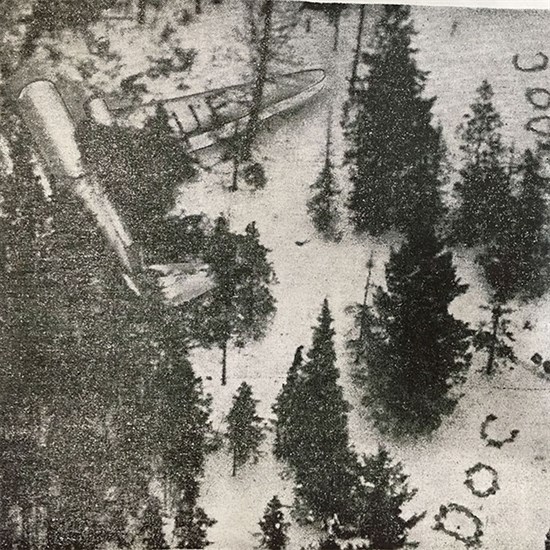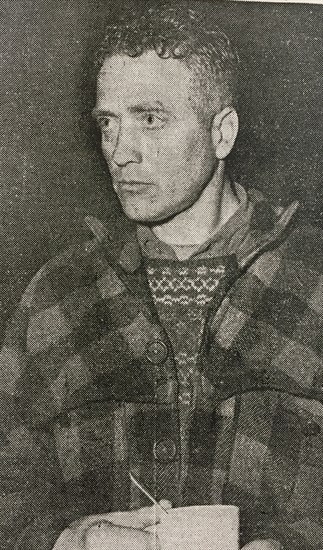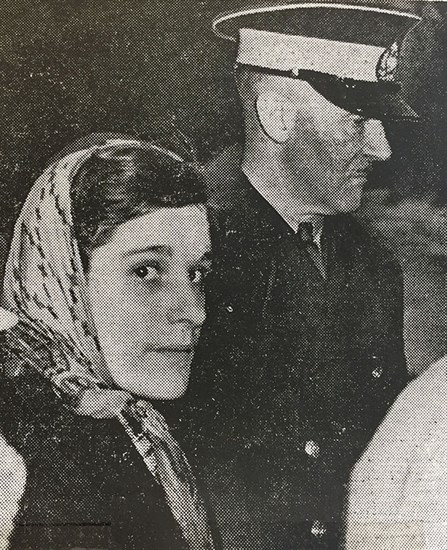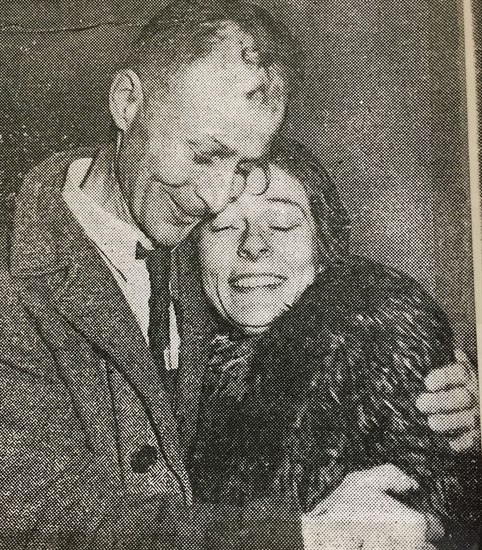
Penticton Regional Airport in December, 2016, with Okanagan Mountain in the distance. Canadian Pacific Airlines Flight 4 from Vancouver was lining up with the runway on Dec. 22, 1950, when the plane crashed into Okanagan Mountain, possibly due to an erroneous reading on the plane's altimeter.
(STEVE ARSTAD / iNFOnews.ca)
December 25, 2022 - 6:00 PM
PENTICTON - This holiday season, as you brave the malls and grumble about shovelling snow, let's recall Christmas 66 years ago, when people from around the South Okanagan — and Naramata in particular — dropped all Christmas preparations to rescue 16 people stranded on Okanagan Mountain.
Newspapers from 1950 called it the “Season of Miracles” but it started, as these things often do, with tragedy.
On Dec. 22, 1950, a Canadian Pacific Air DC-3, bound for Penticton from Vancouver, crashed on Okanagan Mountain.
The 15 passengers and three crew members of Canadian Pacific Flight 4 were in the Christmas spirit as they departed Vancouver just after noon, after two separate delays due to mechanical malfunction and weather. Lightly dressed for city travel, the passengers carried with them Christmas gifts including food and drink, John Peter Shinnick wrote in for the Okanagan Historical Society’s 1980 edition.
The third attempt at take off appeared to be the lucky one, for the flight was uneventful as the plane prepared for final approach to Penticton Regional Airport.
“Everything is all right. You will get to Penticton this time,” the pilot told passengers, just as the plane became obscured in clouds as it lined up for Penticton’s radio beacon to make the final approach.
Within seconds of his announcement, however, things went terribly wrong.

RCAF rescue aircraft's view of a Canadian Pacific DC-3 that crashed on Okanagan Mountain on Dec. 22, 1950.
Image Credit: Penticton Museum and Archives
Passengers recalled hearing scratching as the plane flew through the clouds, just before a wing clipped some trees. Passengers heard the engines rev high as the plane tore through several other trees before crashing, tearing the fuselage apart just behind the cockpit.
The pilot was killed on impact; the co-pilot survived the initial crash but would succumb to his injuries while still stranded on the mountain, more than 36 hours later.
The 15 passengers and stewardess Lorna Franco were dazed, bruised and battered but miraculously, otherwise all right, with not even a broken bone to show from the more than 120 mile per hour impact.
LANDING 'ONE IN A MILLION'
Passengers emptied the plane quickly with little panic. Fortunately, the fuel tanks didn’t rupture and there was no fire, as the plane travelled roughly 400 feet after striking the first tree and ended up almost 180 degrees from its heading, in three feet of snow.
Passenger Fred Savinkoff told the Seattle Times in a story published Dec. 24, 1950: “I thought we were coming down for a landing. I looked out the window and saw trees. I ducked my head and just then we crashed. It wasn’t a bad one. We just seemed to ‘bump’ and stopped.”
He said after a few minutes, the passengers realized the pilots took the brunt of the impact as the cockpit had sheared off from the fuselage.
Savinkoff said the passengers broke into rations on the plane and sat around most of the afternoon as they waited for the sound of rescue aircraft. No one did much talking, he said. They focussed on lighting fires for warmth and rescue signals.
Summerland passenger Dorothy Butler told the Penticton Herald on Dec. 28, 1950, the passengers who were wearing seat belts “seemed to have suffered more bruises,” than those who weren’t, calling the plane’s final position on the mountain, “a successful landing that was one in a million.”

Canadian Pacific Airlines flight 4 from Vancouver to Penticton and on to Castlegar, never made it to the Peach City after crashing on the afteroon of Dec.22, 1950. All the passengers survived, but it took two days for them to get off the mountain.
Image Credit: Penticton Museum and Archives PMA0123
She said several passengers mused the incident was “nothing less than a miracle, but it must be just a dream,” as the afternoon wore on. They thought they were south of Penticton, nearer to Hedley. Many were surprised to find out later they were 16 kilometres northeast of the city on Okanagan Mountain.
“We could hear trains, which confused us,” she said.
Passenger Ora Blackmer, a nurse, and stewardess Franco did what they could for co-pilot Leo Doucette. Pilot Thomas Moore died on impact and Doucette was suffering from a broken pelvis, a broken leg, and shock.
Because of search protocols that existed at the time, seven hours elapsed before a search got underway, with two aircraft initiating a search pattern between Penticton and Princeton, the plane’s last known location.

Passenger Ora Blackmer, was also a nurse. She and stewardess Lorna Franco spent the 36 hours following the crash treating co-pilot Leo Doucette, until he died in the early morning hours of Dec. 24, 1950
Image Credit: Penticton Museum and Archives
The searchers were led to Okanagan Mountain by slash fires burning in the area, but it wasn’t until around midnight on Dec. 22 — 10 hours after the crash — both search aircraft confirmed they saw signal fires on Okanagan Mountain, along with people running around on the ground waving firebrands.
‘A GALLANT FAILURE'
By 3:30 a.m. on the morning of Dec. 23, the first search party was underway, carrying 35-pound backpacks of medical supplies and food. The hikers used old trails located above and beyond the end of Naramata Road, but not knowing precisely where the plane was located, the search party tracked towards the fires, slugging through deep, heavy, wet snow.

Vic Wilson, who owned Paradise Ranch north of Naramata, led the second search party successfully to the downed plane.
Image Credit: Penticton Musum and Archives
Sixteen hours later the party made it to Baker Lake where they spent the night, exhausted, in a tiny cabin.
A request for an air drop of snowshoes was negated by worsening weather conditions, and the group eventually struggled back to Penticton 40 hours later, in an effort the Penticton Herald later called, “a gallant failure.”
As daylight broke on Dec. 23, two RCAF search and rescue planes dropped supplies at the crash site. They saw five passengers alongside the DC-3’s fuselage.
They also noticed pine boughs spelling “DOC,” indicating the need for a doctor, lying in the snow. Twenty hours had elapsed since the plane went down.
RCAF paratrooper Sgt. J. W. Jameson, who wrote an official report of the crash rescue known as Operation Captain, said although helicopters were standing by in Chilliwack, poor weather kept them grounded.
The Canadian Pacific Railway also had several coaches at the Glen Fir loop for survivors, if necessary.
Knowing a doctor was needed, and time becoming a factor, Jameson and two other paratroopers jumped to within 180 metres of the crash site late on the morning of Dec. 23, just as weather conditions began closing in again.
The paratroopers assisted Blackmer and Franco with Doucette, administering morphine and plasma, then prepared a meal, shelter and fires for the rest of the passengers.

Canadian Pacific Airlines stewardess Lorna Franco spent 36 hours tending to co-pilot Leo Ducette, who eventually succumbed to injuries from the crash.
Image Credit: Penticton musum and Archives
'HYSTERICAL AIR OF FESTIVITY TO THE CRASH SITE'
Meanwhile, a second search party led by Paradise Ranch owner Vic Wilson, was successful in their first attempt to reach the crash site, finding their way up the mountain in a brutal four-hour trek through deep snow, heavy precipitation and at times zero visibility.
Wilson, in his account of the rescue, remembered being “haunted by doubts at various times in the trek," having only the vaguest idea of the aircraft’s location after a flyover on the morning of Dec. 23. He was aware aircraft could no longer access the site, the first search party had failed and, with only six hours of daylight, failure was not an option.
The searchers found the crash site by yelling into the dark until they received a response from the survivors around 6 p.m., 28 hours after the crash.
At the site, the rescuers noted some of the passengers got into the liquor and beer as well as Christmas groceries that had been on the plane. Several passengers were drunk, while others could be seen consuming Christmas turkey and desserts.
“Despite the tragedy of the moment, almost everyone involved in the rescue remembers a slightly hysterical air of festivity to the crash site,” Shinnick wrote in his Okanagan Historical Report.
Wilson noted co-pilot Doucette’s critical medical condition, also observing the plane had ended up in a gulley, in the “only fairly clear spot in the area.”
He immediately turned his party around, taking with them Fred Savinkoff, dressed in “oxford shoes and a light rain coat,” Wilson said.
On the way down, Wilson's party met up with a third group, who were bringing a doctor to the crash site.
They continued on to the wreck, with Wilson’s group arriving at a base camp set up at Chute Lake and Gemmil Lake Roads, early in the morning of Dec. 24, where clothing, boots, socks, and toboggans were called up from Penticton.
WIlson’s party was also the first to relay information to a news-hungry public and anxious friends and loved ones that the passengers had all survived. Many friends and family were part of subsequent efforts to retrieve the passengers, including Bob Butler, who hiked to the crash site to reach his sister Dorothy on Christmas Eve.

Summerland passenger Dorothy Butler, whose brother Robert, in photo, hiked to the crash site to help her off the mountain.
Image Credit: Penticton Musum and Archives
Later in the morning of Dec. 24, word that Doucette had died overnight reduced the urgency for transport, and the helicopter based out of Chilliwack was cancelled. Clothing and other supplies were taken up the trail, along with several toboggans to carry out the pilots and possible some elderly passengers.
By noon Dec. 24, the first passengers finally began arriving in Penticton, 46 hours after the crash. They were checked by the RCMP prior to being provided accommodation at the Incola Hotel.
By 4 p.m that day, the last of the 16 survivors, a 70-year-old man, who was “not in too good condition,” according to Sgt. Jameson, arrived in the city - just in time for Christmas Eve.
On Dec. 28, the Penticton Herald editorialized the rescue effort under the heading “Season of miracles.” The newspaper noted it “almost seemed that Naramata volunteered to the last man” to come to the rescue.
Penticton residents who put aside their Christmas priorites during the past three days to help the rescue effort could now focus on the holiday season with renewed enthusiam, while Sgt. Jameson and his crew were able to complete their part in the rescue and make it home to Vancouver in time for Christmas.
— Originally published Dec. 20, 2016
To contact a reporter for this story, email Steve Arstad or call 250-488-3065 or email the editor. You can also submit photos, videos or news tips to the newsroom and be entered to win a monthly prize draw.
We welcome your comments and opinions on our stories but play nice. We won't censor or delete comments unless they contain off-topic statements or links, unnecessary vulgarity, false facts, spam or obviously fake profiles. If you have any concerns about what you see in comments, email the editor in the link above.
News from © iNFOnews, 2022